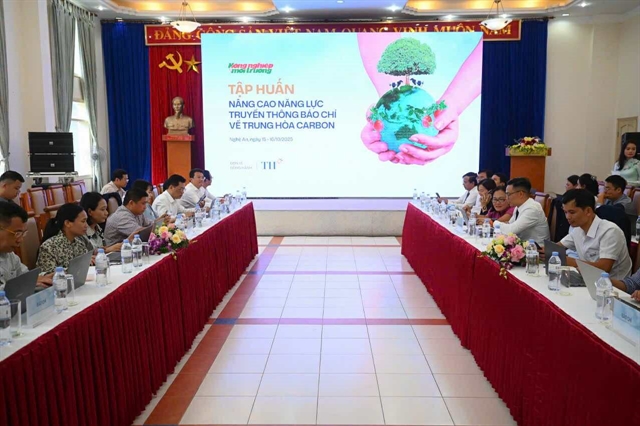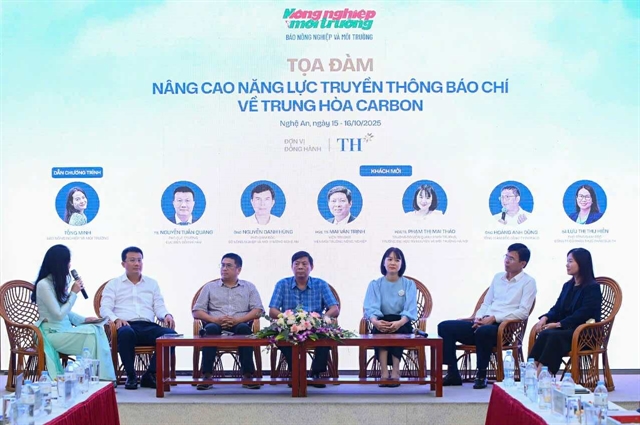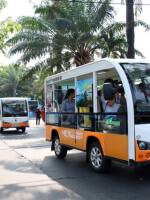
Measuring greenhouse gas emissions and participating in the carbon credit market are opening new opportunities, helping Vietnamese agricultural products enhance their value, affirm their position, and increase global competitiveness.
This was the key theme of the training programme “Enhancing Media Capacity for Carbon Neutrality” organised by the Ministry of Agriculture and Environment on October 15.
According to Assoc. Prof., Dr. Mai Văn Trịnh, Director of the Institute of Agricultural Environment, climate change is affecting all sectors, with agriculture being both impacted and a major source of emissions.
“Measuring and managing greenhouse gas emissions is an essential requirement for moving towards a green, sustainable agriculture,” said Dr. Trịnh.
In Việt Nam, six national greenhouse gas inventories have been conducted, showing the government’s determination to transparently report emission data and fulfill international obligations. Agriculture accounts for a large proportion of the total national emissions, primarily from paddy cultivation, livestock farming, and fertilizer use.
Greenhouse gas emissions not only affect the environment but also directly impact the productivity, quality, and reputation of Vietnamese agricultural products in the international market. The EU, Japan, and the United States have all established carbon standards as technical barriers.
“If we do not proactively control [emissions], Vietnamese agriculture will lose opportunities in the global supply chain,” he said.
Measurement, Reporting, and Verification (MRV) of emissions is the “backbone” of modern carbon governance.

2025 marks a significant turning point as the Government approved the Scheme to establish a domestic carbon market under Decision 232/QD-TTg. The pilot phase from 2025-2028 aims for the official operation of the carbon exchange from 2029, allowing organisations and enterprises to trade and buy/sell “carbon credits” – equivalent to 1 ton of reduced CO₂ emissions.
Additionally, Decree 119/2025/ND-CP has just been issued, supplementing and perfecting the legal framework for the carbon market. It clearly stipulates the responsibilities of ministries, sectors, localities, and enterprises in inventorying and reporting emissions, while also encouraging voluntary and innovative models in emission reduction and carbon absorption.
“If MRV and carbon market participation are handled well, Vietnamese agriculture will not only contribute to achieving the Net Zero 2050 commitment but also open up new revenue streams from carbon credits, providing farmers and businesses with additional motivation to invest in green production,” said Dr. Trịnh.
As carbon becomes a measurable and tradable “asset,” Vietnamese agriculture needs to transform quickly. Investing in emission measurement technology, circular economy models, and international standard MRV will be key for Việt Nam to affirm its position in the global green economy.
According to Deputy Director of the ministry’s Department of Climate Change Nguyễn Tuấn Quang Việt Nam has finalised many important policies to achieve carbon neutrality. The Prime Minister’s Decision No 896/QD-TTg of 2022 approved the National Strategy on Climate Change to 2050, setting a net-zero emissions target by 2050.
On that basis, ministries, sectors, and localities have specified these commitments through action plans, technical guidelines, and management mechanisms. The Ministry of Industry and Trade and the Ministry of Construction have issued circulars on technical standards and energy management, while the Ministry of Agriculture and Environment coordinates in developing national reports and action plans to implement the Net Zero commitment.
From a local perspective, Deputy Director of Nghệ An Province’s Department of Agriculture and Environment Nguyễn Danh Hùng, stated that the locality has proactively applied sustainable development solutions, adapted to climate change, and reduced methane emissions in agriculture. Specifically, Nghệ An is focusing on promoting low-emission agricultural and forestry production models, contributing towards the carbon neutrality goal.
The forestry sector is significantly benefiting as Nghệ An is among the localities with the largest forest area nationwide, boasting over 1.036 million hectares, including 790,000ha of natural forest.
The province has been selected to participate in the North Central Region’s Emission Reduction Payment Agreement (ERPA) programme for the 2023–2025 period, with over 38,400 forest owners receiving payments from carbon credits. This model is likened to “a rain shower in the dry season,” helping locals improve their livelihoods while raising awareness about forest protection.
In livestock farming, Nghệ An, together with TH Group, has pioneered the trend of green production, applying high technology and reducing emissions. Two key enterprises of TH Group have been certified as carbon neutral by Control Union (Netherlands) according to international standard PAS 2060:2014.
“This is a testament to the vision of “green agriculture – circular economy – sustainable development,” while also paving the way for other businesses,” said Hùng.
Additionally, the province is collaborating with pioneering enterprises such as Green Carbon and Faeger to implement a low-emission rice production project, applying the “alternate wetting and drying” technique on over 19,000ha, creating a premise for low-carbon agricultural production.
(VNS)




